Almost three days in Tbilisi this week, two long ones spent training Georgian journalists, left precious little time to see a city I was visiting for the first time.
So I asked my new friend Akaki to show me as much as possible the morning of my departure, which I did on a walking tour of key attractions.
It's a city of contrasts, with apartments and offices in "Soviet Blocks," a local takeoff on the Soviet era's drab buildings that I'd seen in Moscow, Prague, Budapest and Belgrade.
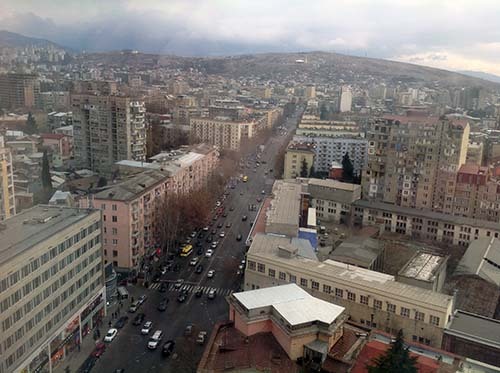
Tbilisi's "Soviet Blocks?" (Abu-Fadil)
(Georgia was for decades under the Soviet umbrella and in a previous era Imperial Russia held sway over the country's affairs. It enjoyed a few years of independence in the early 20th Century, went through a brief civil war in 1991-92, and since 2003 has known relative stability).
But it also features Caucasus-style architecture and modern creations in steel, glass and whatever struck designers' fancy, like the Tbilisi Concert Hall.
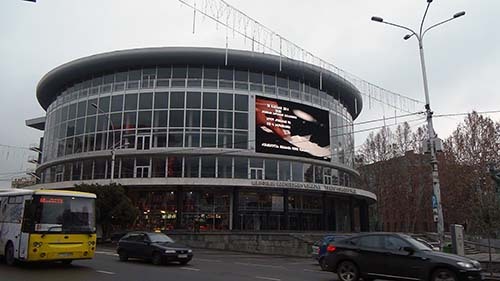
Tbilisi Concert Hall (Abu-Fadil)
A bus ride from my hotel to the older part of town for a mere 28 U.S. Cents meant I could take in some major sites.
Sadly, my brief stay prevented me from actually going inside the ones I really wanted to see, like the museums.
But a walk down Rustaveli Avenue, so named after a 12th Century Georgian poet, on a cold January morning allowed me to appreciate some of the country's history, which my guide recounted with relish.
The Moors, usually associated with Morocco and Andalusia in Spain, influenced Georgians whose capital city Opera House and Theater was built in their architectural tradition.
I wish I could have attended a performance there or seen those acrobatic, toe-hopping Georgian dancers in their colorful traditional costumes.
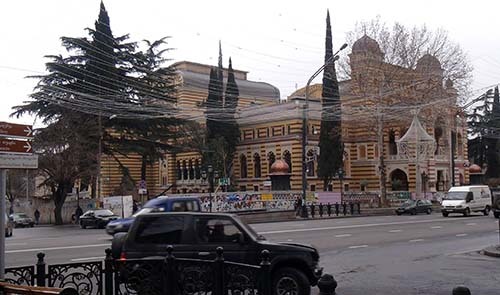
Moorish Opera House and Theater on Rustaveli Avenue (Abu-Fadil)
An impressive gold statue of St. George slaying the dragon and perched atop a column in Freedom Square on the grand avenue caught my eye. The majority of Georgians, I was told, are Orthodox Christians.
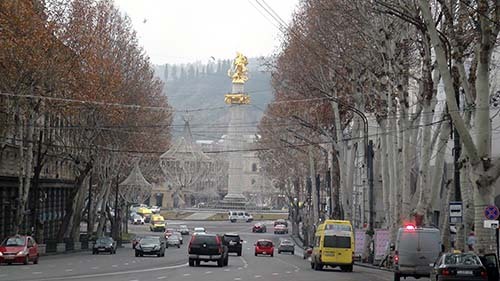
St. George slays the dragon in Freedom Square (Abu-Fadil)
Twice on my short promenade I came across signs for what seemed to be Iraqi businesses.
One publicized "halal" Arabic and Iraqi food, in keeping with Islamic law, and the other held with wires onto a metal gate advertised services of a travel and tourist agency that also dabbled in hotel and apartment reservations, money transfers, translations, exports/imports, accounting and real estate.
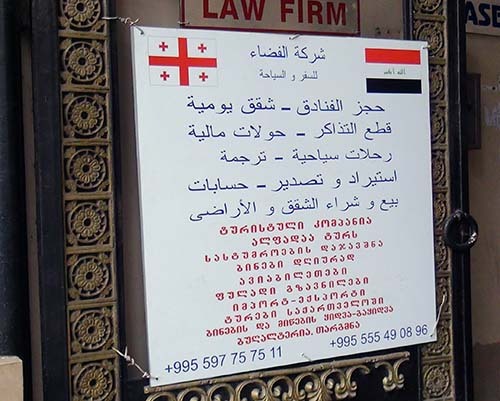
Iraqi jack-of-all-trades firm in Tbilisi (Abu-Fadil)
Other vendors on that street offered local fast foods and snacks but what stood out the most were McDonald's golden arches.
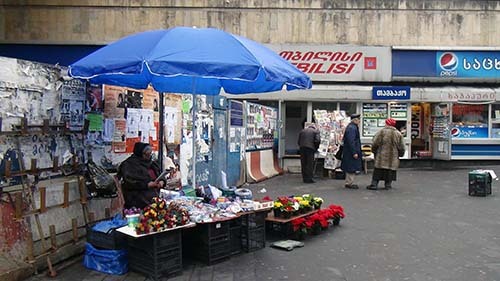
Tbilisi vendors (Abu-Fadil)
From a distance I could see a statue of Kartlis Deda (Mother Georgia) guarding over the city, a welcoming cup of wine for friends in one hand and a sword to ward off enemies in the other.
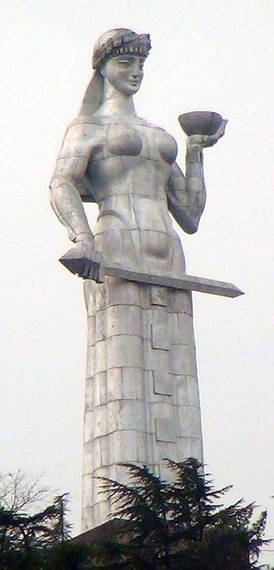
Mother Georgia (Abu-Fadil)
As we strolled down into the older part of the city with cobblestone streets and trendy watering holes, I was taken aback by a purple sign on the side of a building that read: "Medusa Hookah Lounge and Club."
Mercifully there was a no smoking section at the hotel's dining room, but the lounge stunk of tobacco-related products, as did most of the places I visited.
The hills above that gentrified neighborhood offer a panoramic view of expensive restaurants, houses and a cable car where visitors can ride up to the 4th Century Narikala (inaccessible) Fortress.
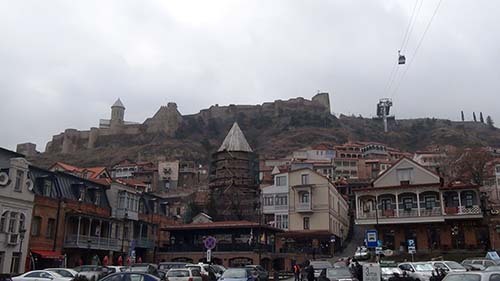
Cable car ride to Narikala Fortress (Abu-Fadil)
There was no shortage of Georgian Orthodox, Armenian Gregorian and Roman Catholic churches along the way. I tried entering two that shared a common courtyard but both were locked.
I bought two cloisonné enamel crosses and a silver crucifix as gifts, along with a typical Georgian hat and other hand-made souvenirs. Requisite bottles of Georgian vodka called "Cha Cha" and cognac are warming reminders of the visit.
The final attraction I caught before heading back to finish packing and going to the airport was the ultra-modern pedestrian bridge cutting across the Mtkvari River.
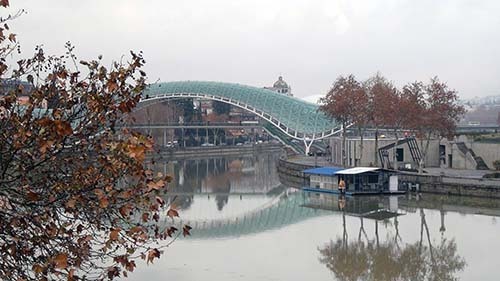
Pedestrian bridge across Mtkvari River (Abu-Fadil)
The various vintages, assorted dishes, hot springs and sulphur baths will have to wait for another visit. "Tbili," I learned, means warm in Georgian.
Our 2024 Coverage Needs You
It's Another Trump-Biden Showdown — And We Need Your Help
The Future Of Democracy Is At Stake
Our 2024 Coverage Needs You
Your Loyalty Means The World To Us
As Americans head to the polls in 2024, the very future of our country is at stake. At HuffPost, we believe that a free press is critical to creating well-informed voters. That's why our journalism is free for everyone, even though other newsrooms retreat behind expensive paywalls.
Our journalists will continue to cover the twists and turns during this historic presidential election. With your help, we'll bring you hard-hitting investigations, well-researched analysis and timely takes you can't find elsewhere. Reporting in this current political climate is a responsibility we do not take lightly, and we thank you for your support.
Contribute as little as $2 to keep our news free for all.
Can't afford to donate? Support HuffPost by creating a free account and log in while you read.
The 2024 election is heating up, and women's rights, health care, voting rights, and the very future of democracy are all at stake. Donald Trump will face Joe Biden in the most consequential vote of our time. And HuffPost will be there, covering every twist and turn. America's future hangs in the balance. Would you consider contributing to support our journalism and keep it free for all during this critical season?
HuffPost believes news should be accessible to everyone, regardless of their ability to pay for it. We rely on readers like you to help fund our work. Any contribution you can make — even as little as $2 — goes directly toward supporting the impactful journalism that we will continue to produce this year. Thank you for being part of our story.
Can't afford to donate? Support HuffPost by creating a free account and log in while you read.
It's official: Donald Trump will face Joe Biden this fall in the presidential election. As we face the most consequential presidential election of our time, HuffPost is committed to bringing you up-to-date, accurate news about the 2024 race. While other outlets have retreated behind paywalls, you can trust our news will stay free.
But we can't do it without your help. Reader funding is one of the key ways we support our newsroom. Would you consider making a donation to help fund our news during this critical time? Your contributions are vital to supporting a free press.
Contribute as little as $2 to keep our journalism free and accessible to all.
Can't afford to donate? Support HuffPost by creating a free account and log in while you read.
As Americans head to the polls in 2024, the very future of our country is at stake. At HuffPost, we believe that a free press is critical to creating well-informed voters. That's why our journalism is free for everyone, even though other newsrooms retreat behind expensive paywalls.
Our journalists will continue to cover the twists and turns during this historic presidential election. With your help, we'll bring you hard-hitting investigations, well-researched analysis and timely takes you can't find elsewhere. Reporting in this current political climate is a responsibility we do not take lightly, and we thank you for your support.
Contribute as little as $2 to keep our news free for all.
Can't afford to donate? Support HuffPost by creating a free account and log in while you read.
Dear HuffPost Reader
Thank you for your past contribution to HuffPost. We are sincerely grateful for readers like you who help us ensure that we can keep our journalism free for everyone.
The stakes are high this year, and our 2024 coverage could use continued support. Would you consider becoming a regular HuffPost contributor?
Dear HuffPost Reader
Thank you for your past contribution to HuffPost. We are sincerely grateful for readers like you who help us ensure that we can keep our journalism free for everyone.
The stakes are high this year, and our 2024 coverage could use continued support. If circumstances have changed since you last contributed, we hope you'll consider contributing to HuffPost once more.
Already contributed? Log in to hide these messages.







